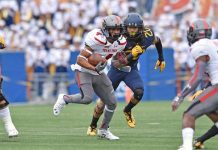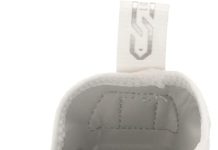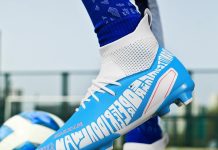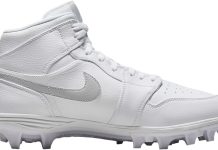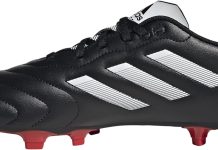Football is a sport that demands precision, agility, and the right equipment to excel. And when it comes to the right equipment, one aspect often goes overlooked but plays a vital role in choosing the right cleats.
Yes, we’re talking about the game-changing footwear that provides stability, traction, and comfort on the field. But with so many options available, it can be overwhelming to figure out which cleats are best for football.
Fear not, because, in this article, we’ve got you covered. We’ll provide you with a comprehensive guide to help you make an informed decision and ensure you’re confidently stepping onto that field.
Factors to Consider
When choosing football cleats, several factors must be considered to ensure you find the best option for your needs. These factors include the playing surface, your position, fit and comfort, durability, and the type of stud used on the cleats.
Playing Surface
The playing surface dramatically affects the type of cleats you should choose. Different playing surfaces require different types of traction to ensure stability and performance.
Review contents
Natural Grass
When playing on natural grass, molded cleats are a popular choice. These cleats have small rubber studs that provide excellent traction without the risk of damaging the grass. Molded cleats are versatile and can be used on dry and wet grass, making them a reliable option for most football players.
Artificial Turf
For artificial turf surfaces, it is best to opt for turf shoes. These cleats have a different sole pattern than molded cleats, with numerous small rubber studs providing excellent traction on artificial surfaces. Turf shoes also typically have a flat sole, which helps to prevent excessive pressure or injuries on the joints.
Hard Ground
Choosing cleats with durable outsole construction is essential when playing on hard ground surfaces, such as gravel or asphalt. Cleats with a thicker and sturdy sole will provide better protection and support on hard surfaces, minimizing the risk of injury.
Indoor Courts
Indoor shoes are the most suitable option for indoor football games played on courts. These shoes have non-marking soles that do not leave scuff marks on the court. Additionally, they provide excellent traction and stability, allowing players to quickly change direction and make sharp movements on the indoor surface.
Position-Specific Cleats
Different positions on the football field require different types of cleats to optimize performance and minimize the risk of injury. Here are some position-specific cleats to consider:
Quarterbacks
Quarterbacks need cleats that offer secure traction on the field while allowing for quick movements and agility. Cleats with a low-profile design and lighter weight are ideal for quarterbacks, providing speed and control.
Wide Receivers
Like quarterbacks, wide receivers require cleats that enhance their speed and agility. Cleats with a good grip and lightweight design are essential for wide receivers to make quick cuts and accelerate down the field.
Linemen
Linemen require excellent traction and stability cleats to hold their ground and prevent slipping during intense plays. Cleats with a sturdy outsole construction and a higher cut provide better ankle support, helping linemen maintain their position and protect against injuries.
Running Backs
Running backs need cleats that allow for explosive speed and quick changes in direction. Cleats with traction and flexibility are crucial for running backs to maximize their performance on the field.
Defensive Backs
Defensive backs require cleats that enable quick reactions and improved acceleration. Cleats with a firm grip and a lightweight design are essential for defensive backs, allowing them to keep up with fast receivers and make decisive plays.
Kickers and Punters
Kickers and punters prioritize accuracy and precision, so they need cleats that provide a stable planting surface. Cleats with a flat sole and minimal stud design allow kickers and punters to achieve optimal contact with the ball, ensuring accurate kicks and punts.
Fit and Comfort
The fit and comfort of football cleats are crucial for optimal performance and injury prevention. Consider the following factors when selecting cleats:
Foot Shape
Players have different foot shapes, and cleats should be chosen based on individual foot characteristics. Narrow, vast, or regular width options are available for most cleat models.
Sizing
Finding the correct size for your cleats is essential to ensure a comfortable fit. Cleats that are too tight can lead to discomfort and potential foot injuries, while cleats that are too loose can result in instability and reduced performance.
Ankle Support
Ankle support is significant for players prone to ankle injuries or participating in positions requiring sudden direction changes. Cleats with a higher cut or added ankle support features can provide stability and protection.
Cushioning
Cushioning inside the cleats helps absorb impact and provides extra comfort, especially during high-intensity games. Look for cleats with sufficient padding and cushioning for enhanced comfort and shock absorption.
Break-in Period
New cleats may require a break-in period to mold to the player’s feet. It is essential to consider the time needed for the cleats to become comfortable and ensure they are suitable for practice and game day.
Durability
Durability is an essential factor when investing in football cleats, as they need to withstand the demands of the game. Pay attention to the following aspects of cleat durability:
Upper Material
The upper material of the cleats contributes to their overall durability. Synthetic materials, such as polyurethane or synthetic leather, are more durable and resistant to wear and tear than genuine leather.
Stitching
The stitching on the upper material and how it is constructed can impact the durability of the cleats. Double stitching and reinforced stitching are desirable features that enhance the lifespan of the cleats.
Outsole Construction
The outsole construction plays a crucial role in the durability of the cleats. Cleats with a sturdy and well-constructed outsole are less likely to separate or undergo damage during intense gameplay.
Stud Type
The stud type on the cleats affects traction and stability on different playing surfaces. Consider the following stud types when choosing your cleats:
Bladed Studs
Bladed studs are long, rectangular-shaped studs that provide excellent traction on natural grass surfaces. They enable players to push off and accelerate quickly, making them a popular choice for players who need quick bursts of speed.
Conical Studs
Conical studs are cone-shaped and offer versatile traction on various playing surfaces. They provide stability and allow for quick changes in direction, making them suitable for both natural grass and artificial turf.
Mixed Studs
Some cleats feature a combination of bladed and conical studs, offering a balance of speed, stability, and versatility. They are famous for players who frequently transition between different playing surfaces.
Molded Cleats
Molded cleats, also known as Fixed or Firm Ground (FG) cleats, have permanently attached studs to the cleat sole. Here are the advantages and disadvantages of molded cleats:
Advantages
- Versatility: Molded cleats can be used on various playing surfaces, including natural grass, artificial turf, and hard ground.
- Durability: The fixed studs on molded cleats are usually more durable than detachable ones.
- Cost-effective: Molded cleats are generally cheaper than detachable cleats, making them a more affordable option for most players.
Disadvantages
- Limited customizability: The fixed stud configuration of molded cleats cannot be changed or adjusted.
- Less adaptability: Molded cleats may not provide optimal traction on certain playing surfaces, as the stud pattern is designed for general use.
Detachable Cleats
Detachable cleats, also known as Screw-In or Soft Ground (SG), have studs that can be unscrewed and replaced with different lengths or types. Consider the advantages and disadvantages of detachable cleats:
Advantages
- Customizability: Detachable cleats allow players to adjust the stud length and type according to the playing surface and personal preference.
- Adaptability: With detachable cleats, switching between different playing surfaces is more accessible by simply changing the studs.
- Enhanced traction: Choosing longer studs allows for better traction on softer ground, muddy or wet grass.
Disadvantages
- Higher cost: Detachable cleats are more expensive than molded cleats due to their versatility and replaceable stud system.
- Stud maintenance: The screws and threads in detachable cleats require regular inspection and tightening to prevent them from coming loose during gameplay.
Indoor Shoes
Indoor shoes are the most suitable choice when playing football on indoor courts, such as gymnasiums or sports halls. Here are the advantages and disadvantages of indoor shoes:
Advantages
- Enhanced traction: Indoor shoes have non-marking soles that provide excellent grip and traction on indoor court surfaces.
- Lightweight: Indoor shoes are generally lighter than outdoor cleats, allowing quicker movements and improved agility on the court.
- Comfort: Indoor shoes are typically designed with extra cushioning and support for enhanced comfort during extended periods of play.
Disadvantages
- Limited to indoor use: Indoor shoes are designed specifically for indoor courts and may not provide adequate traction or support on outdoor surfaces.
- Lack of protection: Indoor shoes may not provide as much ankle support or protection as cleats, which can concern players participating in aggressive play.
In conclusion, when selecting football cleats, you must consider the playing surface, position, fit and comfort, durability, and the type of stud used. By considering these factors, you can find the best cleats for your specific needs, ensuring optimal performance and minimizing the risk of injury on the field.





